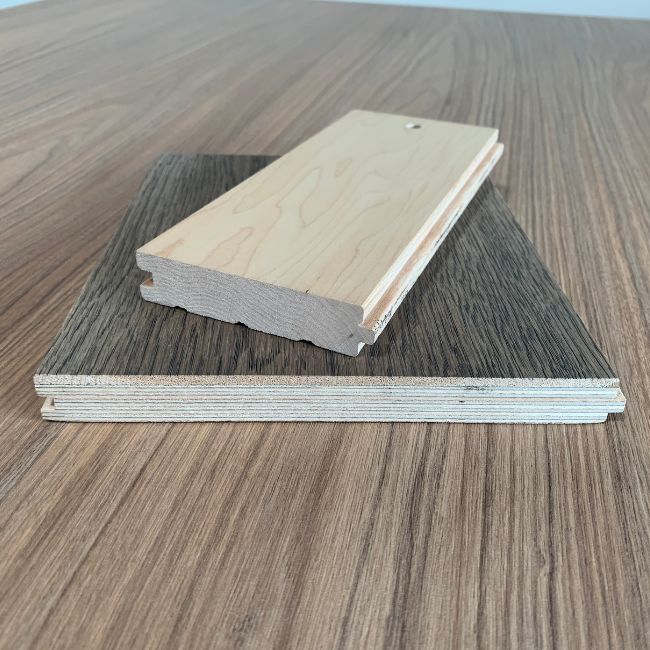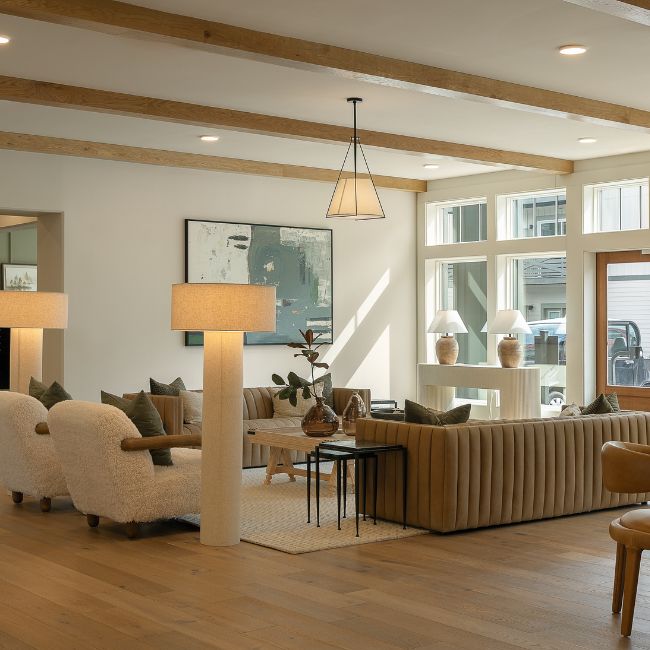Introduction:
In the realm of commercial interior design, selecting the right flooring is about more than aesthetics—it’s about performance, longevity, and sustainability.
Engineered hardwood flooring checks all the boxes, making it a smart, reliable choice for commercial environments.
Below, we break down the key reasons why engineered hardwood is a top contender for commercial projects.
Engineered hardwood is less likely to cup or warp (dimensionally stable).
Dimensional stability is the most significant advantage of engineered hardwood compared to solid wood flooring. In fact, nearly all other benefits stem from this core characteristic.
How Wood Expands:
Solid hardwood is a single, solid piece of wood from top to bottom. Because wood is hygroscopic, it naturally absorbs moisture from the air and expands—primarily in the direction of the growth rings. As a result, solid wood is prone to cupping, warping, and other movement when exposed to changes in relative humidity or temperature.
Why Engineered Hardwood is More Stable:
Engineered hardwood, by contrast, is constructed from multiple layers of wood arranged in a cross-grain configuration. This layered construction gives it superior dimensional stability. Each layer expands in a different direction, effectively balancing out internal expansion forces. This significantly reduces the risk of cupping, warping, or movement due to fluctuations in temperature and moisture.

Freedom to Use Wider Planks
One of the most significant design advantages of engineered hardwood is its ability to accommodate wider planks.
Solid wood is typically limited to about 5 inches in width due to stability concerns, but engineered hardwood can support planks up to 9 inches or more.
This opens the door to more modern, expansive aesthetics—perfect for making a bold design statement in large, open commercial spaces.

Ease of Installation Over Concrete
Remember the dimensional stability we talked about earlier?
That stability makes engineered hardwood an ideal candidate for installation over concrete subfloors using glue-down methods that are both time and cost-efficient. Given that the vast majority of commercial buildings have cementitious subfloors, this is a crucial consideration for interior designers.
How Engineered Flooring Responds to Moisture in Concrete Slabs:
Concrete offers many advantages in the built environment—it’s durable, cost-effective, and naturally flame-resistant. However, when installing wood flooring over concrete, there’s one significant challenge to overcome: moisture.
A 1,000-square-foot concrete slab contains approximately 500 gallons of water that must evaporate during the curing process. Even after curing, the slab continues to absorb moisture from the ground and surrounding air. In effect, it acts like a large, dense sponge.
This persistent presence of moisture can cause problems for wood flooring. As wood absorbs moisture from the slab, it expands. Solid hardwood, with its lower dimensional stability, is far less forgiving in this context. It’s more prone to cupping, warping, and movement in response to even minor humidity or moisture fluctuations.
Engineered hardwood, on the other hand, is much more tolerant of these moisture variations. Thanks to its layered construction, it is significantly less likely to cup, warp, or shrink—making it a more resilient choice for installations over concrete.
Most engineered wood flooring can even be installed in below grade applications like basements. We recommend that installers thoroughly test for moisture prior to installation - especially when installing below grade.
How Gluing Engineered Hardwood Affects Installation Costs:
This ease of installation not only improves performance but also streamlines project timelines and reduces labor costs, making engineered hardwood especially practical for commercial spaces with tight construction schedules.
To ensure optimal performance, we recommend using a moisture-barrier adhesive to protect the flooring from fluctuations in the slab's moisture content.
Refinishing Potential
A common misconception is that engineered hardwood cannot be refinished.
In reality, many products feature wear layers ranging from 2.5mm to 4mm, which allows for one or more refinishes over the floor’s lifespan. This not only extends its longevity but also provides aesthetic flexibility—a unique advantage over materials like LVP or carpet that often get replaced when styles change.
How Refinishing Affects Long Term Life Cycle Cost:
It is typically far more cost effective to refinish or restore an existing wood floor than it is to replace an existing floor. Replacing a floor requires demolition and disposal of the existing flooring. It then requires installation of a new floor that has to be manufactured, transported to the jobsite, and then installed. All of this becomes very expensive over the life of a building as the floor needs to be replaced multiple times.
How Refinishing Impacts Sustainability and Environmental Impact:
Restoring an existing floor is far more environmentally friendly than replacing it. According to the Swedish Environmental Research Institute (IVL), refinishing a wood floor reduces the CO2 by roughly 79% and the energy required by 95% compared to replacing a wood floor with other flooring products like carpet or LVP. That’s a massive benefit to the environment over the lifetime of the building
How many times can an engineered floor be refinished?
Sanding and refinishing a hardwood floor typically removes about 1 mm of material from the wear layer. This means that subtracting “1” from the thickness of the wear layer will give you a ballpark estimate of how many times that floor can be sanded and refinished. As an example a wood floor with a 4 mm wear layer can typically be refinished about 3 times depending on how much material is removed each time. Sanding and refinishing is recommended for wood floors that are significantly damaged or worn, or when the color of the floor needs to be changed.
It’s also possible to “screen and recoat” most wood floors. This is advantageous due to the fact that almost no material is removed. The installer simply buffs out the scratches on the wood floor and applies another coat of topcoat finish. This can be done over and over again over the life of the floor because almost no material is removed. This is a great choice when color change is not needed and no significant damage needs to be repaired.
Wood floors don’t have to be completely replaced to change color—they can simply be refinished with a different stain. This means the floor can evolve alongside the brand identity or design intent of the space.
Sustainability and Environmental Responsibility
Like solid wood, engineered hardwood is an environmentally friendly, carbon-neutral material. Wood in North American is harvested in a very responsible way. Most timber land is owned privately by families who utilize it as a generational income source, so the financial incentives are aligned with good stewardship. In the United States we actually have more standing timber volume that we did in the 1950’s. On average we plant 2.4 hardwood trees for every hardwood tree that is harvested.
How do manufacturing energy sources and use compare to other flooring types?
The primary raw material used to create wood flooring is - you guessed it - wood. The forest is its "factory," and the sun is the primary energy source to produce it. This is significantly different from other flooring types, which typically need to purchase carbon credits to offset the environment costs of producing their products. Wood flooring is by nature carbon neutral. The tree spends its 40-60 year life in the forest absorbing greenhouse gases, releasing oxygen, and creating habitat and food sources for wildlife. No other flooring type as this same positive impact on the environment. Once harvested, wood continues to sequester carbon throughout it’s life.
As sustainability becomes a central pillar in commercial design—especially for firms that are actively integrating mass timber and other sustainable strategies—engineered hardwood aligns perfectly with those values.
What about harmful chemicals and VOC’s?
Most high quality engineered hardwoods are incredibly safe in terms of VOC emissions. They are regulated by the California Air Resources Board. Look for products that are CARB II compliant to ensure whatever wood flooring you specify will be safe.
How do engineered wood floors impact indoor air quality?
Engineered wood floors have a positive affect on outdoor air quality for approximately 40-60 years before the tree is harvested. They also have a positive affect on indoor air quality. Wood is a smooth flooring surface that typically does not harbor allergens like dust, pollen, and animal dander. It allows these irritants to be picked up by the HVAC filter and removed from circulation. Consumers also perceive wood flooring as a clean flooring surface compared to other flooring types.
Maintaining Wood Floors
A properly maintained wood floor can last an incredibly long time. There are ancient churches with wood floors that are over 1,000 years old.
Final Thoughts
Engineered hardwood flooring offers an exceptional balance of design versatility, performance, and environmental responsibility.
With benefits like enhanced dimensional stability, wider plank options, ease of installation, refinishing potential, and sustainable sourcing, it’s a strong choice for commercial interiors that need to look great and stand the test of time.
Engineered Hardwood for Commercial Interiors FAQs
Can engineered hardwood be used in commercial settings?
Yes—its dimensional stability, durability, and design flexibility make it ideal for high-traffic commercial environments.
Is engineered hardwood sustainable?
Yes, it is a carbon-neutral and renewable material when responsibly sourced. Its manufacturing process also makes efficient use of raw wood. The ability to be sanded and refinished means that engineered wood floors can last an incredibly long time - even surviving changes in design preferences. This extended lifecycle means less floor replacement, which greatly reduces the carbon impact of the floor over time.
Can engineered hardwood be installed over concrete?
Absolutely. Engineered hardwood can be glued directly to concrete subfloors, especially when using a moisture-barrier adhesive.
How many times can engineered hardwood be refinished?
Depending on the thickness of the wear layer, it can typically be refinished one to three times over its lifespan.

